ORNO OR-DB-MT-165 Handleiding
Bekijk gratis de handleiding van ORNO OR-DB-MT-165 (4 pagina’s), behorend tot de categorie Deurbel. Deze gids werd als nuttig beoordeeld door 36 mensen en kreeg gemiddeld 4.4 sterren uit 18.5 reviews. Heb je een vraag over ORNO OR-DB-MT-165 of wil je andere gebruikers van dit product iets vragen? Stel een vraag
Pagina 1/4

OR- - -1 DB MT 65
(PL) DZWONEK BEZPRZEWODOWY ONDO 2 AC
(EN) ONDO 2 AC WIRELESS DOORBELL
(DE) ONDO 2 AC DRAHTLOSE FUNKKLINGEL
ORNO-LOGISTIC Sp. z o.o.
ul. Rolników 437
44-141 Gliwice POLAND
tel. 32 43 43 110(+48)
(PL) WAŻNE!
Przed rozpoczęciem korzystania z urządzenia, należy zapoznać się z niniejszą instrukcją obsługi oraz zachować ją na przyszłość. Dokonanie samodzielnych napraw i modyfikacji
skutkuje utratą gwarancji. Producent nie odpowiada za uszkodzenia mogące wyniknąć z nieprawidłowego montażu czy eksploatacji urządzenia. Z uwagi na fakt, że dane
techniczne podlegają ciągłym modyfikacjom, Producent zastrzega sobie prawo do dokonywania zmian dotyczących charakterystyki wyrobu oraz wprowadzania innych
rozwiązań konstrukcyjnych niepogarszających parametrów i walorów użytkowych produktu. Dodatkowe informacje na temat produktów marki ORNO dostępne są na:
www.support.orno.pl. Orno- niniejszej instrukcji. Firma Orno-Logistic Sp. z o.o. Logistic Sp. z o.o. nie ponosi odpowiedzialności za skutki wynikające z nieprzestrzegania zaleceń
zastrzega sobie prawo do wprowadzania zmian w instrukcji - aktualna wersja do pobrania ze strony www.support.orno.pl. ania oraz Wszelkie prawa do tłumaczenia/interpretow
prawa autorskie niniejszej instrukcji są zastrzeżone.
1. Nie używaj urządzenia niezgodnie z jego przeznaczeniem.
2. Nie zanurzaj urządzenia w wodzie i innych płynach.
3. Czyść delikatnie zwilżoną szmatką po wyłączeniu z sieci 230V.
4. Nie przykrywaj urządzenia podczas pracy.
5. Nie obsługuj urządzenia, gdy uszkodzona jest obudowa.
6. Nie rozkręcaj urządzenia i nie dokonuj samodzielnych napraw.
7. Produkt nie jest zabawką, trzymać z dala od dzieci.
(EN) IMPORTANT!
Before using the device, read this Service Manual and keep it for future use. Any repair or modification carried out by yourselves results in loss of guarantee. The manufacturer
is not responsible for any damage that can result from improper device installation or operation. In view of the fact that the technical data are subject to continuous modifications,
the manufacturer reserves a right to make changes to the product characteristics and to introduce different constructional solutions without deterioration of the product
parameters or functional quality. Additional information about ORNO products are available at support.orno.pl. www. Orno-Logistic Sp. z o.o. holds no responsibility for the
results of non-compliance with the provisions of the present Manual. Orno Logistic Sp. z o.o. reserves the right to make changes to the Manual - the latest version of the Manual
can be downloaded from www.support.orno.pl Any translation/interpretation rights and copyright in relation to this Manual are reserved..
1. Do not use the device contrary to its dedication.
2. Do not immerse the device in water or other fluids.
3. Clean with a slightly moistened cloth after switching off the power (230V).
4. Do not cover the device during operation.
5. Do not operate the device when the housing is damaged.
6. Do not disassemble the device and do not repair it yourself.
7. This product is not a toy, keep it out of reach of children.
(DE) WICHTIG!
Machen Sie sich mit dem Inhalt der Bedienungsanleitung vertraut, bevor sie mit der Nutzung der Anlage beginnen. Die Durchführung eigenmächtiger Reparaturen und
Modifikationen hat den Verlust der Garantie zur Folge. Der Hersteller haftet für Beschädigungen nicht, die sich aus der nicht fachgerechten Montage oder Einsatz der Anlage
ergeben. Erzeugnischarakteristik und anderer Da technische Daten ständigen Modifikationen unterliegen, behält sich der Hersteller das Recht vor, Änderungen bezüglich
Konstruktionsänderungen vorzunehmen, die Parameter und Nutzwerte des Produkts nicht beeinträchtigen. Zusätzliche Informationen zum Thema der Produkte der Marke
ORNO finden Sie auf der Internetseite: www.support.orno.pl. Die Orno-Logistic Sp. z o.o. haftet nicht für die Folgen der Nichteinhaltung der Empfehlungen, die in dieser
Bedienungsanleitung zu finden sind. Die Orno-Logistic Sp. z o.o. behält sich das Recht auf Änderungen in der Bedienungsanleitung vor – die aktuelle Version kann man von der
Internetseite www.support.orno.pl herunterladen. Alle Rechte auf Übersetzung/Interpretation sowie Urheberrechte an dieser Bedienungsanleitung sind vorbehalten.
1. beschriebenen Zwecken Benutzen Sie das Gerät ausschließlich zu den in dieser Anweisung
2. Tauchen Sie das Gerät nicht ins Wasser oder in andere Flüssigkeiten.
3. Reinigen Sie nach dem Ausschalten des Stroms (230V) mit einem leicht angefeuchteten Tuch.
4. Decken Sie das Gerät während des Betriebs nicht ab.
5. Nutzen Sie das Gerät nicht, wenn sein Gehäuse beschädigt ist.
6. Bauen Sie das Gerät nicht auseinander und reparieren Sie es nicht selbst.
7. Dieses Produkt ist kein Spielzeug, bewahren Sie es außerhalb der Reichweite von Kindern auf.
Każde gospodarstwo jest użytkownikiem sprzętu elektrycznego i elektronicznego, a co za tym idzie potencjalnym wytwórcą niebezpiecznego dla ludzi i środowiska odpadu, z tytułu obecności w sprzęcie
niebezpiecznych substancji, mieszanin oraz części składowych. Z drugiej strony zużyty sprzęt to cenny materiał, z którego możemy odzyskać surowce takie jak miedź, cyna, szkło, żelazo i inne.
Symbol przekreślonego kosza na śmieci umieszczany na sprzęcie, opakowaniu lub dokumentach do niego dołączonych oznacza, że produktu nie wolno wyrzucać łącznie z innymi odpadami. Oznakowanie
oznacza jednocześnie, że sprzęt został wprowadzony do obrotu po dniu 13 sierpnia 2005 r. Obowiązkiem użytkownika jest przekazanie zużytego sprzętu do wyznaczonego punktu zbiórki w celu
właściwego jego przetworzenia. Informacje o dostępnym systemie zbierania zużytego sprzętu elektrycznego można znaleźć w punkcie informacyjnym sklepu oraz
w urzędzie miasta/gminy. Odpowiednie postępowanie ze zużytym sprzętem zapobiega negatywnym konsekwencjom dla środowiska naturalnego i ludzkiego zdrowia!
Every household is a user of electrical and electronic equipment and therefore a potential producer of hazardous waste to humans and the environment from the presence of hazardous substances,
mixtures and components in the equipment. On the other hand, waste equipment is a valuable material, from which we can recover raw materials such as copper, tin, glass, iron and others.
The symbol of a crossed-out rubbish bin placed on the equipment, packaging or documents attached thereto indicates the necessity of separate collection of waste electrical and electronic equipment.
Products marked in this way, under penalty of a fine, may not be disposed of in ordinary waste together with other waste. The marking also means that the equipment was placed on the market after the
13th August 2005. It is the user’s responsibility to hand over the waste equipment to a designated collection point for proper treatment. Used equipment may also be returned to the seller in case of
purchase of a new product in a quantity not greater than the new purchased equipment of the same type. Information about the available waste electrical equipment collection system can be found at
the information point of the shop and in the municipal office. Proper handling of waste equipment prevents negative consequences for the environment and human health!
Jeder Haushalt ist ein Benutzer von Elektro- und Elektronikgeräten und daher ein potenzieller Produzent von gefährlichen Abfällen für Mensch und Umwelt, da die Geräte gefährliche Stoffe, Gemische und
Komponenten enthalten. Andererseits sind gebrauchte Geräte ein wertvolles Material, aus dem wir Rohstoffe wie Kupfer, Zinn, Glas, Eisen u.a. gewinnen können. Das Symbol des durchgestrichenen
Mülleimers auf Geräten, Verpackungen oder den angehängten Dokumenten deutet auf die Notwendigkeit der getrennten Sammlung von Elektro- und Elektronik-Altgeräten hin. So gekennzeichnete
Produkte dürfen unter Androhung einer Geldstrafe nicht mit dem Hausmüll entsorgt werden. Diese Kennzeichnung bedeutet gleichzeitig, dass das Gerät nach dem 13. August 2005 in Verkehr gebracht
wurde. Der Benutzer soll die Altgeräte einer festgelegten Sammelstelle zur entsprechenden Entsorgung zuführen. Gebrauchtgeräte können auch an den Verkäufer übergeben werden, wenn Sie ein neues
Produkt in einer Menge kaufen, die nicht höher ist als die der neu gekauften Ausrüstung desselben Typs. Informationen zum verfügbaren Sammelsystem für Elektroaltgeräte finden Sie am Informationspunkt
des Geschäfts und im Stadt- / Gemeindeamt. Der sachgemäße. Umgang mit gebrauchten Geräten verhindert negative Folgen für die Umwelt und die menschliche Gesundheit!
06/2021

2
BUDOWA/ CONSTRUCTION/ AUFBAU
Odbiornik/ Receiver /Empfänger
Nadajnik/ Transmitter/ Sender
BUDOWA ODBIORNIKA
RECEIVER’S CONSTRUCTION
KONSTRUKTION DES EMPFÄNGERS
1. Dioda LED
2. Głośnik
3. Przycisk parowania / regulacja głośności
4. Przycisk zmiany melodii
1. Bell LED
2. Speaker
3. Pairing / volume setting button
4. Ringtone change button
1. Dioden-LED
2. Lautsprecher
3. Kopplung / Lautstärkeregelungstaste
4. Klingelton- Änderungstaste
BUDOWA NADAJNIKA
TRANSMITTER’S CONSTRUCTION
KONSTRUKTION DES SENDERS
1. Dioda LED
2. Przycisk dzwonka
3. Otwory służące do otwierania (tył)obudowy
4. Otwory montażowe
1. Button LED
2. Ring button
3. Holes for opening the housing (rear)
4. Openings for mounting onto a wall
1. Dioden-LED
2. Klingeltaste
3. Löcher zum Öffnen Gehäuses des (hinten)
4. Montagelöcher
DANE TECHNICZNE
napięcie nominalne
(odbiornik):
nominal voltage (receiver):
Nennspannung (Empfänger):
230V~, 50Hz
częstotliwość:
frequency:
Frequenz:
433,92 MHz
transmisja:
transmission:
Übertragung:
Radiowa/radio/ Funkübertragung
pobór prądu odbiornika:
receiver power consumption:
der Stromverbrauch des Empfängers:
0,4W
pobór prądu nadajnika:
transmitter power consumption:
der Stromverbrauch des Senders:
<10mW
zasięg w terenie otwartym:
range in the open field:
Reichweite im Freifeld:
M 200 m ax.
poziom głośności:
volume level:
Lautstärkepegel:
60-90 dB
stopień ochrony nadajnika:
transmitter’s protection level:
Schutzart des Senders:
IP44
wymiary odbiornika (z
wtyczką):
dimensions of the receiver (incl. plug):
Abmessungen des Empfängers (inkl. Stecker):
81x81x72mm
wymiary nadajnika:
dimensions of the transmitter:
Abmessungen des Senders:
82x50x21,5mm
waga odbiornika:
weight of the receiver:
Gewicht des Empfängers:
0,075 kg
waga nadajnika:
weight of the transmitter:
Gewicht des Senders:
0,049 kg
temperatura pracy:
working temperature:
Arbeitstemperatur:
- C C 40°÷+65°
PL
Instrukcja obsługi i montażu
OPIS I ZASTOSOWANIE
Dzwonek bezprzewodowy i bezbateryjny przeznaczony jest do stosowania w domach, mieszkaniach, biurach, szpitalach, sklepach itp. Nie wymaga instalacji
dzwonkowej. Służy do sygnalizacji dźwiękowej i świetlnej. Dzwonek (odbiornik) włączany jest bezpośrednio do gniazdka sieci ~230V, a nadajnik zasilany jest z
przetwornika elektromechanicznego nie wymaga stosowania baterii. N diody LED. Funkcja learning system i aciśnięcie przycisku sygnalizowane jest błyśnięciem
umożliwia logowanie dodatkowych przycisków W nadawaniu i odbieraniu sygnału wykorzystywana jest częstotliwość radiowa 433,92MHz. Zasięg dzwon. ka w terenie
otwartym wynosi do 200 Odbiornik posiada 4- od 60 do 90 oraz 36 polifoniczn dzwonka do wyboru. Zestaw zawiera dwa m. stopniową regulację głośności dB e dźwięki
odbiorniki (dzwonki) oraz jeden nadajnik (przycisk).
MONTAŻ/INSTALACJA
MONTAŻ NADAJNIKA (PRZYCISKU)
1. Przed montażem zaloguj przycisk w pamięci dzwonka.
2. Przed montażem upewnij się, że miejsce, w którym chcesz zamontować przycisk nie utrudnia komunikacji między nadajnikiem, a odbiornikiem.
3. Włóż śrubokręt w otwory z tyłu nadajnika i zdejmij tylną pokrywę.
4. Do montażu użyj klejącej taśmy dwustronnej (dołączonej do zestawu) lub dwóch śrub. Pomimo tego, że przycisk jest odporny na warunki zewnętrzne, zaleca się
zamontować go w osłoniętym miejscu, np. p2-we wnęce ściany.
5. Załóż tylną pokrywę.
6. Naciśnij przycisk w celu wywołania świeci się dioda LED co oznacza, że urządzenie przekazało sygnał do odbiornika. melodii. Gdy naciskasz przycisk, za
Wewnątrz pomieszczenia usłyszysz zaprogramowaną wcześniej melodię.
Uwaga: przycisk dzwonka (nadajnik) można bez problemu zamontować na powier się zchniach drewnianych i murowanych Dzwonek nie nadaje . do montażu na
powierzchniach metalowych rantuje lub wykonanych z materiałów zawierających metalowe elementy, np. oprawy okien, drzwi. Montaż na takich powierzchniach nie gwa
właściwego działania nadajnika.
MONTAŻ ODBIORNIKA (DZWONKA)
1. Dzwonek przeznaczony jest do montażu wewnątrz pomieszczeń.
2. Dzwonek należy podłączyć do gniazdka 230V AC, wokół którego jest wolna przestrzeń.
3. Zasięg działania urządzeń wynosi maksymalnie 200m, jednak zależy od warunków wokół urządzeń t a ścian, przez które sygnał musi przeniknąć, akich jak: liczb
metalowe ościeżnice drzwi i inne elementy, które mogą wpłynąć na jakość przesyłania sygnału (inne urządzenia działające na podobnej częstotliwości radiowej,
np. termometry bezprzewodowe, urządzenia do automatycznego sterowania bramą, itp.) Zakres odbierania sygnałów może się znacznie zmniejszyć z w/w
powodów.
OBSŁUGA
WYBÓR DŹWIĘKU DZWONKA
1. Kilka razy naciśnij na odbiorniku przycisk (4).
2. Po każdym naciśnięciu usłyszysz inną melodię. Do wyboru jest 36 różnych dźwięków. Melodia odegrana jako ostatnia będzie przypisana jako dzwonek.
GŁOŚNOŚĆ SYGNAŁU DŹWIĘKOWEGO
1. Skala głośności dzwonka ma 4 poziomy do wyboru. Naciśnij na odbiorniku przycisk (3).
2. Każde naciśnięcie powoduje zmianę na inny poziom. Wybierz poziom głośności, który odpowiada twoim preferencjom.
LOGOWANIE
1. Podłącz dzwonek do sieci (230V AC).
2. Naciśnij i przytrzymaj ok. 5 sekund przycisk parowania (3) na odbiorniku.
3. Zaświeci się dioda LED, zwolnij przycisk parowania. Przez ok. 25 sekund dzwonek będzie w trybie parowania. W tym czasie naciśnij przycisk dzwonka. Usłyszysz
wybraną melodię co oznacza, że przycisk został sparowany z odbiornikiem. Etap ten automatycznie kończy tryb parowania.
4. W celu zalogowania wielu przycisków, powtórz cały proces dla każdego przycisku.
Uwaga: odbiornik posiada wbudowaną pamięć, w której zapisuje kody wszystkich zalogowanych przycisków na wypadek braku zasilania. Po przywróceniu zasilania nie ma
potrzeby ponownego logowania przycisków.

3
KASOWANIE PAMIĘCI
1. Naciśnij i przytrzymaj przycisk parowania (3) na odbiorniku.
2. Włóż odbiornik do gniazdka sieciowego.
3. Po ok. 5 sekundach zaświeci się dioda LED. Zwolnij przycisk.
4. Dioda LED zgaśnie.
5. Kody wszystkich zalogowanych przycisków zostały skasowane z pamięci urządzenia.
PRZYPISANIE MELODII
1. Wykasuj pamięć odbiornika (patrz pkt. Kasowanie pamięci).
2. Naciśnij i przytrzymaj przycisk parowania (3) aż zaświeci się dioda LED.
3. Wybierz melodię przyciskami (4).
4. Naciśnij przycisk nadajnika.
5. Aby skonfigurować drugi i kolejny nadajnik powtórz kroki od 2 do 4.
NIEKTÓRE PROBLEMY I ROZWIĄZANIA
Dzwonek nie dzwoni:
- dzwonek może nie mieć wystarczającego zasięgu – zmień odległość pomiędzy nadajnikiem i odbiornikiem, rzeczywisty zakres działania może być zaburzony przez
warunki wokół urządzeń,
- gniazdku jest zasilanie.dzwonek nie jest podłączony do zasilania – upewnij się, że dzwonek jest poprawnie włożony do gniazdka sieciowego i że w
CZYSZCZENIE I KONSERWACJA
Bezprzewodowy dzwonek jest delikatnym urządzeniem elektronicznym. Z tego względu należy przestrzegać następujących zaleceń:
- odbiornik nadaje się do montażu wewnątrz pomieszczeń, w środowisku suchym,
- odbiornik należy podłączyć w łatwo dostępnym miejscu tak, by umożliwić jego łatwą obsługę i odłączenie,
- odbiornika poprawne działanie należy sprawdzać okresowo,
- odbiornika i przycisku na zbytnie wibracje i uderzenia, nie narażaj
- nie wystawiaj odbiornika i przycisku na działanie nadmiernego ciepła, bezpośrednich promieni słonecznych i wilgoci,
- czyść delikatnie zwilżoną szmatką z odrobiną środka czyszczącego, nie używaj żrących detergentów lub rozpuszczalników.
Uproszczona deklaracja zgodności:
Orno-Logistic Sp. z o.o. niniejszym oświadcza, że typ urządzenia radiowego: - - -165 Bezprzewodowy dzwonek ONDO 2 jest zgodny z dyrektywą 2014/53/UE Pełen tekst deklaracji OR DB MT AC .
zgodności UE jest dostępny pod następującym adres internetowym: www.support.orno.pl.
EN
Operating and installation instructions
DESCRIPTION AND USE
Wireless and battery-free doorbell is designed to be used in homes, apartments, offices, hospitals, shops, etc. It does not require a cable connection. It provides sound
and visual signals. The receiver (doorbell is plugged directly into a ~230V socket and the transmitter is powered by the electromechanical transducer - battery is not )
required. Pressing of the button initiates LED diode flashing. The learning system is used to easily log in additional buttons Radio frequency 433.92MHz is used for .
transmitting and receiving the signal. The range in the open field is up to 20 . The receiver has a 4- volume adjustment from 60 dB and 36 polyphonic 0m step to 90
ringtones to choose from. The set contains two receivers (bells) and one transmitter (button).
INSTALLATION
Installation of the transmitter (button):
1. Begin by pairing the button with the doorbell.
2. Before installation, check that the pair works reliably in the chosen spot.
3. Remove the rear cover by inserting a screwdriver into the hole on the back of the button.
4. Use the double-sided adhesive tape (included) or two screws. Although the button is weather resistant, choose a location where it is protected, e.g. in a wall
recess.
5. Re-assemble the button.
6. Press the button to ring the doorbell. Pressing is accompanied by LED illumination indicating the button has sent a radio signal. The doorbell plays the selected
ringtone.
Note: the doorbell button (transmitter) can be placed on wood or brick walls without any issue. However, never place the button directly onto metal objects or materials
containing metal, such as plastic windows or doors that have metal frame. In such cases, the transmitter will not work proper ly.
Installation of the receiver (doorbell ):
1. The doorbell is designed for indoor use only.
2. When running, it must be plugged in a 230V AC socket, with free space around it so that it is always accessible.
3. The transmission range (max. 200m) is influenced by local conditions such as the number of walls through which the signal passes, metal door frames and other
elements which affect the transmission of radio signals (presence of other radio devices operating at a similar frequency, such as wireless thermometers, gate
controls, etc.) Transmission range can decrease drastically due to these factors.
OPERATION
RINGTONE SELECTION
1. Repeatedly press the ringtone change button (4) located on the doorbell.
2. Each press of the button will play a different ringtone. There are 36 ringtones to choose from. The last ringtone played is the one that will be used.
SETTING THE VOLUME
1. You can set one of the 4 volume levels. Repeatedly press the (3) button on the doorbell.
2. Each press changes the volume. Select the volume level that best suits your preferences.
LOGIN
1. Plug the doorbell unit into a 230V AC socket.
2. Long-press the pairing button (3) on the doorbell, for ca. 5 seconds.
3. The doorbell L will light up. Release the pairing button. The doorbell will switch to self-learning pairing mode which lasts for 25 seconds. During this time, press ED
the ring button. The doorbell will ring and the button is now paired with the doorbell. This automatically ends self-learning mode.
4. To pair multiple buttons, repeat the process for each button from step 1.
Note: the doorbell has an internal memory where it stores the codes of the currently paired buttons for the event of a power failure. There is thus no need to pair buttons
again after a power cut.
MEMORY CLEARING
1. Press and hold the pairing button (3) on the doorbell.
2. Plug the chime into a socket.
3. The LED of the doorbell will light up after ca. 5 seconds. Release the pairing button.
4. The LED will turn off.
5. The memory of all paired buttons will be erased.
MELODY ASSIGNMENT
1. Delete the memory of the receiver (see Memory Clearing).
2. Press and hold the pairing button (3) until the LED lights up.
3. Select the melody using the buttons (4).
4. Press the transmitter button.
5. To configure the second and next transmitter repeat steps 2 to 4.
SOME PROBLEMS AND SOLUTIONS
The doorbell does not ring:
- the doorbell may be out of range change the distance between the button and the doorbell. The range may be affected by local conditions. –
- the doorbell is not powered make sure the doorbell is properly plugged into the socket and that the power is on.–
Product specificaties
| Merk: | ORNO |
| Categorie: | Deurbel |
| Model: | OR-DB-MT-165 |
Heb je hulp nodig?
Als je hulp nodig hebt met ORNO OR-DB-MT-165 stel dan hieronder een vraag en andere gebruikers zullen je antwoorden
Handleiding Deurbel ORNO
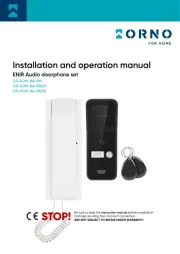
11 Juni 2025
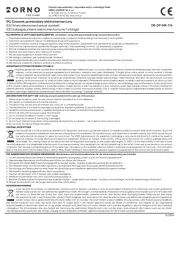
11 Juni 2025
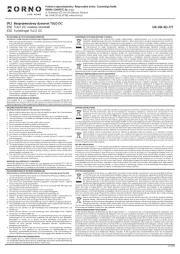
11 Juni 2025
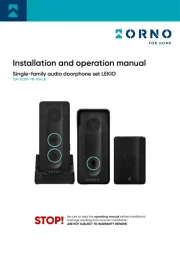
11 Juni 2025
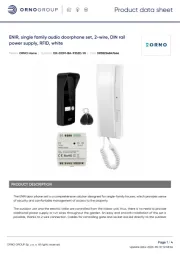
10 Juni 2025
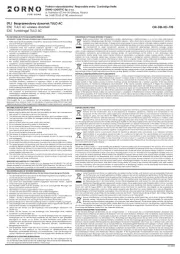
10 Juni 2025

3 December 2024

3 December 2024

22 Augustus 2024

22 Augustus 2024
Handleiding Deurbel
- Lorex
- NuTone
- Arlo
- Meross
- KlikaanKlikuit
- Arendo
- Legrand
- ZAMEL
- Brilliant
- Urmet
- Swissvoice
- REV
- DIO
- Lifetec
- Doro
Nieuwste handleidingen voor Deurbel
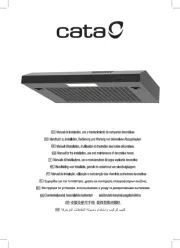
29 Juli 2025
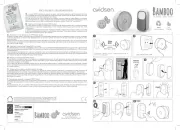
14 Juli 2025
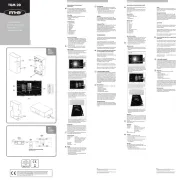
5 Juli 2025
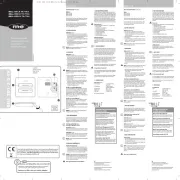
5 Juli 2025
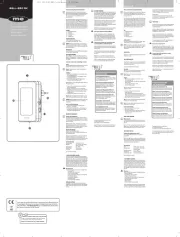
5 Juli 2025
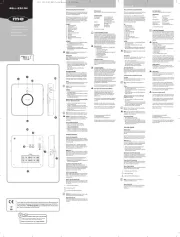
5 Juli 2025
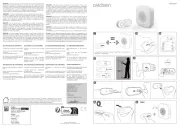
15 Juni 2025
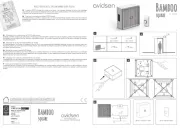
15 Juni 2025
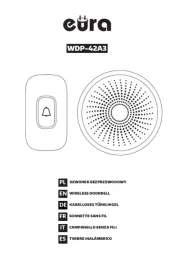
19 Mei 2025
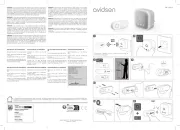
28 April 2025